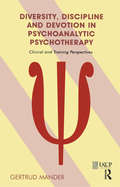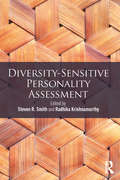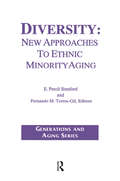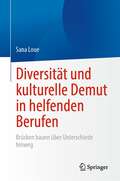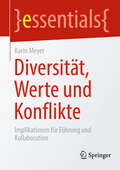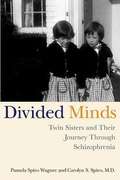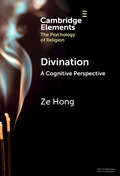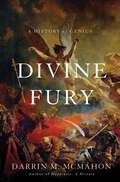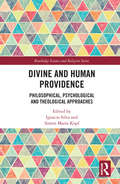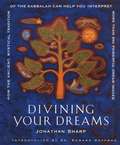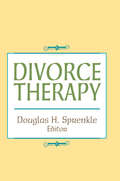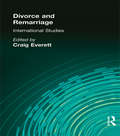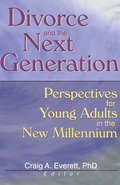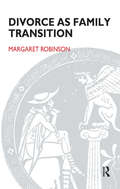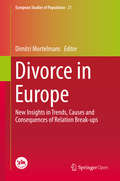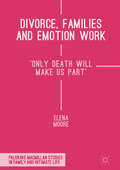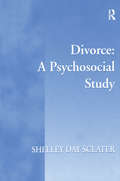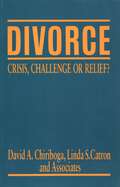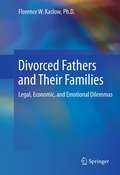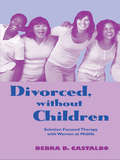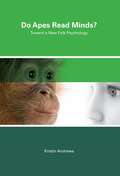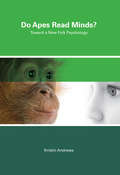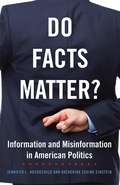- Table View
- List View
Diversity, Discipline and Devotion in Psychoanalytic Psychotherapy: Clinical and Training Perspectives (The\united Kingdom Council For Psychotherapy Ser.)
by Gertrud ManderThis book is a selection of papers written over 25 years of practising psychoanalytic psychotherapy, of training and supervising psychotherapists, psychodynamic counsellors and supervisors. It reflects a preoccupation with the growth and diversification of counselling and psychotherapy, with the imperatives of training, supervision and regulation, and with the significant changes in the profession due to the invention of brief, time-limited, intermittent and recurrent psychotherapy. An overall theme is the conviction that what patients and therapists share is vulnerability, and that the therapist is a 'wounded healer', whose reparative tendency informs his professional choice, his therapeutic empathy and his capacity to bear the rigours of therapeutic work. Thus an unconscious connection between the helper and the helped is the driving force of every therapeutic relationship, for better and for worse. Its responsible management requires thorough training, ongoing supervision and a firm frame in order to contain the powerful forces operating when two strangers meet for the purpose of therapy.
Diversity-Sensitive Personality Assessment
by Steven R. Smith and Radhika KrishnamurthyDiversity-Sensitive Personality Assessment is a comprehensive guide for clinicians to consider how various aspects of client diversity—ethnicity, gender, sexual orientation, age, nationality, religion, regionalism, socioeconomic status, and disability status—can impact assessment results, interpretation, and feedback. Chapters co-written by leading experts in the fields of diversity and personality assessment examine the influence of clinician, client, interpersonal, and professional factors within the assessment context. This richly informed and clinically useful volume encourages clinicians to delve into the complex ways in which individuals’ personal characteristics, backgrounds, and viewpoints intersect. This book fills an important gap in the personality assessment literature and is an essential resource for clinicians looking to move beyond surface-level understandings of diversity in assessment.
Diversity: New Approaches to Ethnic Minority Aging
by E. Percil StanfordContaining ideas and perspectives, this monograph examines the evolutionary and future considerations for diversity in aging.
Diversität und kulturelle Demut in helfenden Berufen: Brücken bauen über Unterschiede hinweg
by Sana LoueAllzu oft hat die Ausbildung in kultureller Kompetenz zu einer unbeabsichtigten Ausgrenzung einiger Personen und Gruppen und zur Verstärkung bestehender Stereotypen geführt. Dieser Text erforscht das Konzept der kulturellen Demut, das einen spannenden Weg nach vorne für diejenigen bietet, die in helfenden Berufen tätig sind. Im Gegensatz zu kultureller Kompetenz fordert kulturelle Demut den Einzelnen heraus, sich auf einen lebenslangen Kurs der Selbstprüfung und des transformativen Lernens einzulassen, der es ihm ermöglicht, authentischer mit Klienten, Patienten, Kollegen und anderen umzugehen. Das Buch zeichnet unser Verständnis von und unsere Reaktionen auf Vielfalt und Integration im Laufe der Zeit nach, wobei der Schwerpunkt auf den Vereinigten Staaten liegt.Zu den untersuchten Themen gehören:Wir und die Anderen: Die Konstruktion von KategorienKulturelle Kompetenz als Ansatz zum Verstehen von UnterschiedenTransformatives Lernen durch kulturelle BescheidenheitFörderung von kultureller Demut im institutionellen/organisatorischen KontextKulturelle Demut und die helfende FachkraftDas Buch zeigt anhand von Beispielen, wie das Konzept der kulturellen Bescheidenheit auf institutioneller Ebene und im Kontext individueller Interaktionen, z. B. zwischen einem Gesundheitsdienstleister oder Therapeuten und einem Klienten, umgesetzt werden kann.Diversität, kulturelle Demut und die helfenden Berufe: Building Bridges Across Difference" ist eine unverzichtbare Lektüre für Gesundheitsberufe (Krankenpflege, Medizin), Sozialarbeit, Psychologie, Kunsttherapie und andere helfende Berufe.
Diversität, Werte und Konflikte: Implikationen für Führung und Kollaboration (essentials)
by Karin MeyerDialog-, Konflikt- und Kollaborationsfähigkeit zählen zu den „Future Skills“. Gleichzeitig kann der Umgang mit Heterogenität (über-)fordern. Dabei ist es möglich, verschiedene Werte, Maßstäbe und Sichtweisen in Einklang zu bringen. Konflikte können vermieden sowie Potenziale und Kreativität unterschiedlicher Perspektiven erfolgreich genutzt werden, um in einer immer komplexer und dynamischer werden Arbeitswelt erfolgreich zu sein.
Divided Minds: Twin Sisters and Their Journey Through Schizophrenia
by Pamela Spiro Wagner Carolyn S. SpiroGrowing up in the 1950s, Carolyn Spiro was always in the shadow of her more intellectually dominant and socially outgoing twin, Pamela. But as the twins approached adolescence, Pamela began to succumb to schizophrenia, hearing disembodied voices and eventually suffering many breakdowns and hospitalizations. Divided Minds is a dual memoir of identical twins, now in their fifties, one of whom faces a life sentence of schizophrenia, and the other who becomes a psychiatrist, after entering the spotlight that had for so long been focused on her sister. Told in the alternating voices of Carolyn and Pamela, Divided Minds is a heartbreaking account of the far reaches of madness, as well as the depths of ambivalence and love between twins. It is a true and unusually frank story of identical twins with very different identities and wildly different experiences of the world around them.
Divination: A Cognitive Perspective (Elements in the Psychology of Religion)
by Ze HongThis Element adopts a naturalistic, cognitive perspective to understand divination. Following an overview of divination and the historical background of its scholarly study, Section 2 examines various definitions and proposes a working definition that balances common usage with theoretical coherence. Section 3 surveys existing theories of divination, including symbolic and functional perspectives, while critiquing their limitations. Section 4 argues for the primacy of cognition in divinatory practices, emphasizing the role of universal cognitive mechanisms and culturally specific worldviews in shaping their plausibility and persistence. Expanding on these ideas, Section 5 investigates the interplay between individual cognition and societal processes, highlighting socio-cultural factors such as the preferential reporting of successful outcomes that bolster divination's perceived efficacy. Finally, Section 6 concludes by summarizing the Element's key arguments and identifying open questions for future research on the cognitive dimension of divination.
Divine Fury: A History of Genius
by Darrin M. McmahonGenius. The word connotes an almost unworldly power: the power to create, to grasp universal secrets, even to destroy. As renowned intellectual historian Darrin McMahon explains in "Divine Fury," the concept of genius can be traced back to antiquity, when men of great insight were thought to be advised by demons. The modern idea of genius emerged in tension with a growing belief in human equality; contesting the notion that all are created equal, geniuses served to dramatize the exception of extraordinary individuals not governed by ordinary laws. Today, the idea of genius has become cheapened?rock stars and football coaches earn the term with seemingly the same ease as astrophysicists and philosophers?yet our enduring fascination with it reflects the desires, needs, and fears of ordinary human beings. The first comprehensive history of this mysterious yet foundational concept, "Divine Fury" follows the fortunes of genius from Socrates to Napoleon to Einstein and beyond, analyzing its democratization, disappearance, and potential rebirth.
Divine and Human Providence: Philosophical, Psychological and Theological Approaches (Routledge Science and Religion Series)
by Ignacio Silva Simon KopfThis volume offers an original perspective on divine providence by examining philosophical, psychological, and theological perspectives on human providence as exhibited in virtuous human behaviours. Divine providence is one of the most pressing issues in analytic theology and philosophy of religion today, especially in view of scientific evidence for a natural world full of indeterminacies and contingencies. Therefore, we need new ways to understand and explain the relations of divine providence and creaturely action. The volume is structured dynamically, going from chapters on human providence to those on divine providence, and back. Drawing on insights from virtue ethics, psychology and cognitive science, the philosophy of providence in the face of contingent events, and the theology of grace, each chapter contributes to an original overall perspective: that human providential action is a resource suited specifically to personal action and hence related to the purported providential action of a personal God. By putting forward a fresh take on divine providence, this book enters new territory on an age-old issue. It will therefore be of great interest to scholars of theology and philosophy.
Divining Your Dreams
by Jonathan Sharp Edward HoffmanYour Dreams Can Show You the Way We all know that our dreams mean something, but do you realize that your dreams can actually help you? In the Kabbalistic tradition, dreams are prized as the key that unlocks the spiritual door leading to a path of greater wisdom. In this rich and unique guide you will learn how simple and practical steps can help you use the messages in your dreams to unleash healing, creativity, and personal fulfillment. Kabbalistic experts Jonathan Sharp and Dr. Edward Hoffman clearly explain how the Kabbalah works, along with its varied, mysterious, and fascinating components. These include the Tree of Life, the Tarot deck, the hundred most important symbols from Zohar (the ancient text on which the Kabbalah is based), and the numerology of the letters in the Hebrew alphabet. Following is a comprehensive list of more than eight hundred and fifty dream images with interpretations, evaluations, and unique prescriptions to help bring energy and inspiration to your spiritual journey. Each dream entry includes: Meaning: An overview of the image's significance as well as a numerological evaluation and interpretation Tree of Life: What the dream tells the dreamer about where she is on her life path, specifically in terms of spiritual development and emotional relationships The Journey: Practical advice on what steps to take so that you can use your dream to take you where you want to go -- solve problems, explore possibilities, find the inspiration to live more deeply, and much more Rich, comprehensive, and full of beauty and mystery, Divining Your Dreams will be a bedside companion for years to come.
Divorce Therapy
by Charles Figley, PhdExamine a wide variety of divorce therapy approaches with this seminal book. Divorce Therapy is one of the first books to present a comprehensive approach to divorce therapy. Based on a foundation of theory and research about divorce, this landmark volume focuses on the help that psychotherapists can provide during the three stages of divorce--pre-divorce decision making, divorce restructuring, and post-divorce recovery. A distinguished array of researchers and clinicians address discuss mediation, criteria for a constructive divorce, remarriage, custody issues, and much more.
Divorce and Remarriage: International Studies
by Craig EverettDivorce and Remarriage brings together for the first time a unique collection of international studies focusing on many aspects of divorce particular to individual cultures. It looks at the implications of divorce on the personal level, as well as on the broader social level, in several different countries. On the personal level, it discusses smoking and alcohol use as stress factors in marriage and the effects of divorce on children, and, on the social level, it discusses a country’s level of development and urbanization and its impact on marriage patterns and divorce rates. With divorce rates soaring, it is more important than ever to understand why people worldwide are failing to adopt sounder mate selection and marriage timing practices. To give readers a glimpse of the divorce experience from a global perspective, the authors of Divorce and Remarriage contrast divorce processes and issues in their countries with other experiences worldwide. The book explores consensual partnering and its relation to patterns of marriage and divorce, the differences between fathers without custody and mothers with custody, and fathers’and children’s ethical and legal rights and the importance of their emotional and social relationships. It also discusses the importance of determining the connection between maternal attitudes and the development of children, as well as the relationship between parental separation/divorce and adolescent values. Other topics discussed at length in this important book are: the possible stress prevention role of social support in the post-separation period nontraditional stepfamily lifestyles and the well-being of adolescents in different cultures maternal stress and its impact on children widowhood and remarriage in different countries long-standing marital problems and their effect on each gender predictors of national marriage rates single parents’distress Divorce and Remarriage provides educators, researchers, mental health clinicians, and policymakers with information that can help alleviate the stress divorce causes for both individuals and society as a whole. The book’s model for evaluating the readiness of a couple for separation or divorce, its recommendations for mediation, and innovative ideas for providing single parents with better social networking and services are sure to improve the way divorces, parental rights, and children’s interests are handled around the world.
Divorce and the Next Generation: Perspectives for Young Adults in the New Millennium
by Craig EverettCan the children of broken homes learn to trust promises of commitment?The repercussions of divorce on children has been hotly debated for years. Divorce and the Next Generation: Perspectives for Young Adults in the New Millennium offers solid, peer-reviewed research into the aftermath of divorce. This valuable volume presents a scientific look at an issue that all too often is discussed in ideological terms. This sequel to the groundbreaking Divorce and the Next Generation (published in 1993) examines the emotional, relational, and even physiological effects of divorce. It offers helpful tables and figures, thorough literature reviews, and metanalysis as well as original research. The studies analyze such diverse factors as gender, age at divorce, and level of conflict in the marriage. The results may surprise you.This book takes a close look at the psychological interactions of divorce with many areas of children’s emotional functioning, including: relationship with parents interpersonal relationships attitudes toward intimacy and marriage self-blame and self-esteem gender schematizationDivorce and the Next Generation, brings together some of the leading researchers in the field. These detailed studies in the lingering aftereffects of divorce will be of interest to psychologists, family therapists, and policymakers.
Divorce as Family Transition: When Private Sorrow Becomes A Public Matter (The Systemic Thinking and Practice Series)
by Margaret RobinsonBased on the 1996 Family Law Act, this book looks at how the therapist can work with the different professions involved in a divorce, how children might be consulted, and ways in which vulnerable family members can be protected. 78 pages.
Divorce in Europe: New Insights in Trends, Causes and Consequences of Relation Break-ups (European Studies of Population #21)
by Dimitri MortelmansThis open access book collects the major discussions in divorce research in Europe. It starts with an understanding of divorce trends. Why was divorce increasing so rapidly throughout the US and Europe and do we see signs of a turn? Do cohabitation breakups influence divorce trends or is there a renewed stability on the partner market?In terms of divorce risks, the book contains new insights on Eastern European countries. These post socialist countries have evolved dramatically since the fall of the Wall and at present they show the highest divorce figures in Europe. Also the influence of gender, and more specifically women’s education as a risk in divorce is examined cross nationally. The book also provides explanations for the negative gradient in female education effects on divorce. It devotes three separate parts to new insights in the post-divorce effects of the life course event by among others looking at consequences for adults and children but also taking the larger family network into account. As such the book is of interest to demographers, sociologists, psychologists, family therapists, NGOs, and politicians.“This wide-ranging volume details important trends in divorce in Europe that hold implications for understanding family dissolution causes and consequences throughout the world. Highly recommended for researchers and students everywhere.”
Divorce in Psychosocial Perspective: Theory and Research
by Joseph GuttmannMany books deal with divorce and its aftermath -- some deal with the impact of divorce on children and families, others with the legal or sociological aspects of divorce, and a few focus on divorced mothers and fathers. Most of these books are characterized by their practical orientation toward the issues and problems posed by divorce. None of these, however, have attempted to offer an integrated view of the massive amount of theoretical and research literature on divorced adults and their children. In addition, none present a comprehensive view of divorce as a psychological process within its larger social context. Filling that void, this book: * offers a comprehensive view of divorce as a social, interpersonal and psychological phenomenon, * reviews the theory and research on divorce focusing on the major protagonists of the divorce drama: the mother, the father and the children, and * introduces a social-psychological theory of divorce process.
Divorce, Families and Emotion Work
by Elena MooreThis book focuses on parental commitment to family life, after divorce, in contrast to its common perception as an irrevocable breaking up of the family unit, which is often perpetuated by representations from popular culture and the media. In the first detailed review of emotions and emotion work undertaken by divorced parents, the author sheds light on how parents manage feelings of guilt, fear, on-going anger and everyday unhappiness in the course of family life post-divorce. Moore demonstrates how the emotional dimension of divorce is shaped by societal and structural factors and requires parents to undertake considerable emotion work in the creation of new moral identities. The book points to the often gendered responsibilities for sustaining family lives post separation, and how these reflect extensive inequalities in family practices. The author concludes that divorce is not dangerous for society; it is not a social evil or a demonstration of the rise of selfish individualism, and that divorcees remain committed to former partners and children long after divorce. This book will be of interest to scholars and students in the areas of Sociology, Psychology, Family Studies, Social Policy, Social Work and Law.
Divorce: A Psychosocial Study
by Shelley Day SclaterSeveral jurisdictions have attempted to render divorce more harmonious by abolishing matrimonial 'fault' and facilitating the resolution of divorce disputes by mediation. In Britain, these provisions appear in the Family Law Act 1996. The book presents a challenge to the underlying assumptions that conflict and the adversarial system are undesirable. Its focus is on adults’ experiences of divorce. In a series of interviews, divorcing people told their own stories of divorce. The personal narratives revealed that divorce can be emotionally traumatic, but it has positive sides too. The emotions of divorce are not pathological , but are readily explicable as ordinary human coping strategies , in the context of the real material privations that many divorcing people suffer. These coping strategies often involve conflict and acrimony. From a psychodynamic perspective, it is argued that these are integral, and psychologically necessary, aspects of the divorce process. This book is particularly topical in the light of the recent decision of the British Government to postpone the implementation of the Family Law Act 1996 and the acknowledged need for research to inform policy.
Divorce: Crisis, Challenge, Or Relief?
by David A. Chiriboga Linda S. CatronNot since William Goode's Women in Divorce in the 1950's have we had such a comprehensive study of adjustment to divorce. This longitudinal work views divorce as a transition process which may have positive or negative outcomes over time. In addition to statistical analysis, the book includes very interesting case studies to demonstrate the dynamic events occurring as individuals refashion their lives after the breakup of their marriages. Researchers on divorce and the interested public will find this book very valuable for years to come."-Colleen L. Johnson, Ph.D.ProfessorMedical Anthropology, University of California, San Francisco We are witnessing a steady increase in the overall number of older adults who are divorced, yet the majority of divorce research has concerned itself with persons in the younger adult years. This unique, groundbreaking book addresses the critical need for information on the impact of divorce on individuals in all age groups, and pays special attention to age as a factor in the effects of divorce on both men and women. Written by an interdisciplinary team of social and behavioral scientists, Divorce: Crisis, Challenge or Relief? provides the invaluable results gained from their life span study of divorced adults. Divorce is the product of hundreds of interviews containing a host of very specific questions conducted with divorced adults between the ages of 20 and 79, both just after their divorce and again several years later.
Divorced Fathers and Their Families
by Florence W. KaslowThis book focuses on the experience of father's lives after a divorce, and how mental health professionals can help them create a healthy transition. Through the use of case examples critical issues are highlighted and discussed with supportive empirical findings and clinical insights. Traditionally, the marital legal sessions as well as the ultimate marriage settlement focus on the issues confronted by the ex-wife and mother and on the custody and visitation plan for the children. This is actually supported by law in some places. This can remove the father from important qualitative issues such as what it is like to have children in two households, relationships with two sets of grandparents, where holidays will be spent, fair rotations of responsibility and how continuing parental discord can be resolved. The issues examined in this volume are relevant to a range of professionals who deal with divorcing couples from psychologists and family therapists to legal advisors and judges.
Divorced, without Children: Solution Focused Therapy with Women at Midlife (Routledge Series on Family Therapy and Counseling)
by Debra D. CastaldoThe topic of women divorced at midlife without children is one that has, to date, been absent from professional and academic literature, though these women make up a considerable and growing portion of our population. This book explores the experience, meaning, and impact of divorce at midlife for women without children, and provides insights into the unique stressors and issues confronting these individuals so that the practitioner can better anticipate and meet their needs. Clinical considerations and case examples will be presented via the narrative stories of women who have experienced this unusual role in a world that is still primarily centered on marriage and mothering. This book provides case examples, clinical themes, treatment recommendations, and suggests coping techniques and strategies. Castaldo draws heavily upon social constructionist, feminist, and narrative perspectives as theoretical frameworks for the book, as well as the results of her own qualitative research study. She suggests new concepts for women’s psychological development, including: an expanded family life cycle to include a normalized stage of mature single adulthood and a developmental process of autonomous competence for women. Other critical coping skills include meaning modification, role innovation, self-nurturing, expanded intimacy and attachment, and multi-diverse industriousness.
Do Apes Read Minds?
by Kristin AndrewsBy adulthood, most of us have become experts in human behavior, able to make sense of the myriad behaviors we find in environments ranging from the family home to the local mall and beyond. In philosophy of mind, our understanding of others has been largely explained in terms of knowing others' beliefs and desires; describing others' behavior in these terms is the core of what is known as folk psychology. In Do Apes Read Minds? Kristin Andrews challenges this view of folk psychology, arguing that we don't consider others' beliefs and desires when predicting most quotidian behavior, and that our explanations in these terms are often inaccurate or unhelpful. Rather than mindreading, or understanding others as receptacles for propositional attitudes, Andrews claims that folk psychologists see others first as whole persons with traits, emotions, and social relations. Drawing on research in developmental psychology, social psychology, and animal cognition, Andrews argues for a pluralistic folk psychology that employs different kinds of practices (including prediction, explanation, and justification) and different kinds of cognitive tools (including personality trait attribution, stereotype activation, inductive reasoning about past behavior, and generalization from self) that are involved in our folk psychological practices. According to this understanding of folk psychology -- which does not require the sophisticated cognitive machinery of second-order metacognition associated with having a theory of mind -- animals (including the other great apes) may be folk psychologists, too.
Do Apes Read Minds?: Toward a New Folk Psychology
by Kristin AndrewsAn argument that as folk psychologists humans (and perhaps other animals) don't so much read minds as see one another as persons with traits, emotions, and social relations.By adulthood, most of us have become experts in human behavior, able to make sense of the myriad behaviors we find in environments ranging from the family home to the local mall and beyond. In philosophy of mind, our understanding of others has been largely explained in terms of knowing others' beliefs and desires; describing others' behavior in these terms is the core of what is known as folk psychology. In Do Apes Read Minds? Kristin Andrews challenges this view of folk psychology, arguing that we don't consider others' beliefs and desires when predicting most quotidian behavior, and that our explanations in these terms are often inaccurate or unhelpful. Rather than mindreading, or understanding others as receptacles for propositional attitudes, Andrews claims that folk psychologists see others first as whole persons with traits, emotions, and social relations.Drawing on research in developmental psychology, social psychology, and animal cognition, Andrews argues for a pluralistic folk psychology that employs different kinds of practices (including prediction, explanation, and justification) and different kinds of cognitive tools (including personality trait attribution, stereotype activation, inductive reasoning about past behavior, and generalization from self) that are involved in our folk psychological practices. According to this understanding of folk psychology—which does not require the sophisticated cognitive machinery of second-order metacognition associated with having a theory of mind—animals (including the other great apes) may be folk psychologists, too.
Do Facts Matter? Information and Misinformation in American Politics
by Jennifer L. Hochschild Katherine Levine EinsteinA democracy falters when most of its citizens are uninformed or misinformed, when misinformation affects political decisions and actions, or when political actors foment misinformation--the state of affairs the United States faces today, as this timely book makes painfully clear. In Do Facts Matter? Jennifer L. Hochschild and Katherine Levine Einstein start with Thomas Jefferson's ideal citizen, who knows and uses correct information to make policy or political choices. What, then, the authors ask, are the consequences if citizens are informed but do not act on their knowledge? More serious, what if they do act, but on incorrect information? Analyzing the use, nonuse, and misuse of facts in various cases--such as the call to impeach Bill Clinton, the response to global warming, Clarence Thomas's appointment to the Supreme Court, the case for invading Iraq, beliefs about Barack Obama's birthplace and religion, and the Affordable Care Act--Hochschild and Einstein argue persuasively that errors of commission (that is, acting on falsehoods) are even more troublesome than errors of omission. While citizens' inability or unwillingness to use the facts they know in their political decision making may be frustrating, their acquisition and use of incorrect "knowledge" pose a far greater threat to a democratic political system. Do Facts Matter? looks beyond individual citizens to the role that political elites play in informing, misinforming, and encouraging or discouraging the use of accurate or mistaken information or beliefs. Hochschild and Einstein show that if a well-informed electorate remains a crucial component of a successful democracy, the deliberate concealment of political facts poses its greatest threat.
Do Fathers Matter?: What Science Is Telling Us About the Parent We've Overlooked
by Paul RaeburnFor too long, we've thought of fathers as little more than sources of authority and economic stability in the lives of their children. Yet cutting-edge studies drawing unexpected links between fathers and children are forcing us to reconsider our assumptions and ask new questions: What changes occur in men when they are "expecting"? Do fathers affect their children's language development? What are the risks and rewards of being an older-than-average father at the time the child is born? What happens to a father's hormone levels at every stage of his child's development, and can a child influence the father's health? Just how much do fathers matter? In Do Fathers Matter? the award-winning journalist and father of five Paul Raeburn overturns the many myths and stereotypes of fatherhood as he examines the latest scientific findings on the parent we've often overlooked. Drawing on research from neuroscientists, animal behaviorists, geneticists, and developmental psychologists, among others, Raeburn takes us through the various stages of fatherhood, revealing the profound physiological connections between children and fathers, from conception through adolescence and into adulthood—and the importance of the relationship between mothers and fathers. In the process, he challenges the legacy of Freud and mainstream views of parental attachment, and also explains how we can become better parents ourselves. Ultimately, Raeburn shows how the role of the father is distinctly different from that of the mother, and that embracing fathers' significance in the lives of young people is something we can all benefit from. An engrossing, eye-opening, and deeply personal book that makes a case for a new perspective on the importance of fathers in our lives no matter what our family structure, Do Fathers Matter? will change the way we view fatherhood today.
